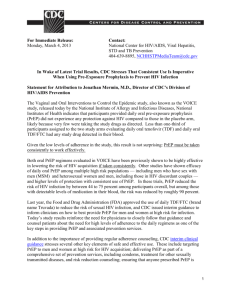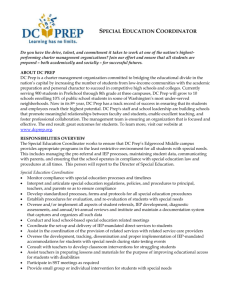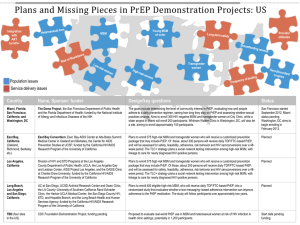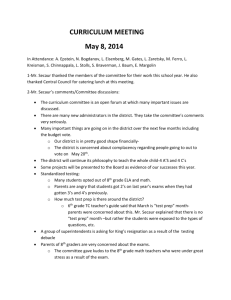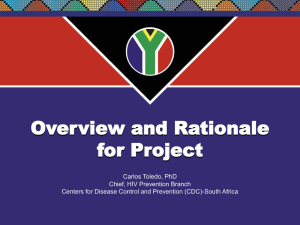For immediate release: July 13, 2011 Contact: Mitchell Warren
advertisement
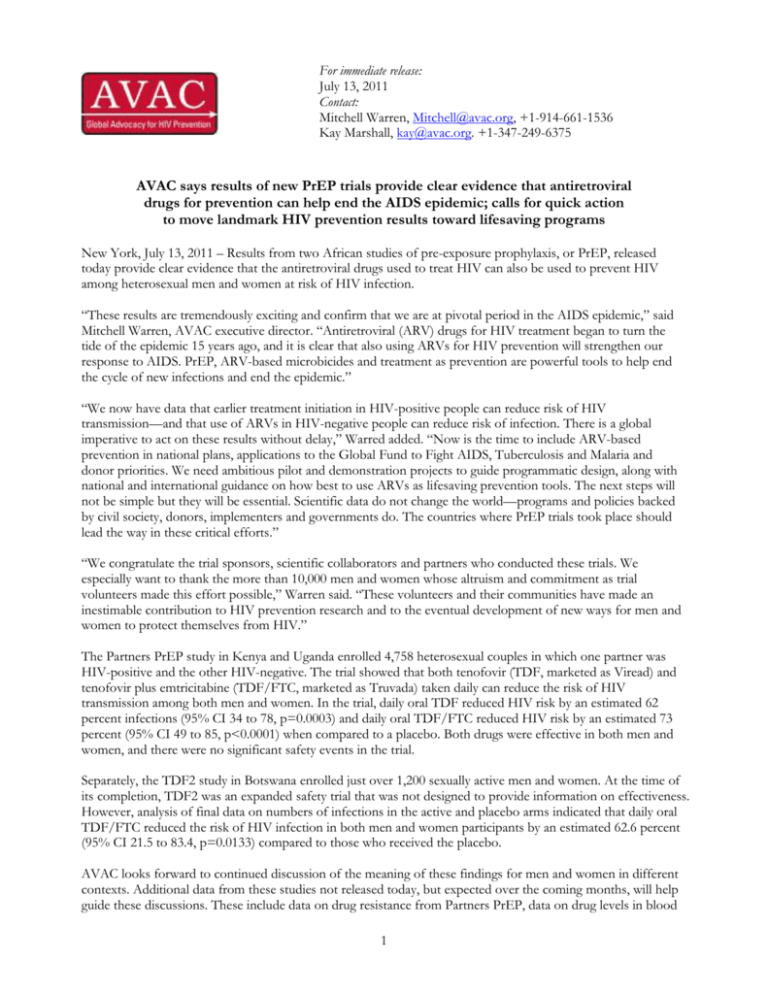
For immediate release: July 13, 2011 Contact: Mitchell Warren, Mitchell@avac.org, +1-914-661-1536 Kay Marshall, kay@avac.org. +1-347-249-6375 AVAC says results of new PrEP trials provide clear evidence that antiretroviral drugs for prevention can help end the AIDS epidemic; calls for quick action to move landmark HIV prevention results toward lifesaving programs New York, July 13, 2011 – Results from two African studies of pre-exposure prophylaxis, or PrEP, released today provide clear evidence that the antiretroviral drugs used to treat HIV can also be used to prevent HIV among heterosexual men and women at risk of HIV infection. “These results are tremendously exciting and confirm that we are at pivotal period in the AIDS epidemic,” said Mitchell Warren, AVAC executive director. “Antiretroviral (ARV) drugs for HIV treatment began to turn the tide of the epidemic 15 years ago, and it is clear that also using ARVs for HIV prevention will strengthen our response to AIDS. PrEP, ARV-based microbicides and treatment as prevention are powerful tools to help end the cycle of new infections and end the epidemic.” “We now have data that earlier treatment initiation in HIV-positive people can reduce risk of HIV transmission—and that use of ARVs in HIV-negative people can reduce risk of infection. There is a global imperative to act on these results without delay,” Warred added. “Now is the time to include ARV-based prevention in national plans, applications to the Global Fund to Fight AIDS, Tuberculosis and Malaria and donor priorities. We need ambitious pilot and demonstration projects to guide programmatic design, along with national and international guidance on how best to use ARVs as lifesaving prevention tools. The next steps will not be simple but they will be essential. Scientific data do not change the world—programs and policies backed by civil society, donors, implementers and governments do. The countries where PrEP trials took place should lead the way in these critical efforts.” “We congratulate the trial sponsors, scientific collaborators and partners who conducted these trials. We especially want to thank the more than 10,000 men and women whose altruism and commitment as trial volunteers made this effort possible,” Warren said. “These volunteers and their communities have made an inestimable contribution to HIV prevention research and to the eventual development of new ways for men and women to protect themselves from HIV.” The Partners PrEP study in Kenya and Uganda enrolled 4,758 heterosexual couples in which one partner was HIV-positive and the other HIV-negative. The trial showed that both tenofovir (TDF, marketed as Viread) and tenofovir plus emtricitabine (TDF/FTC, marketed as Truvada) taken daily can reduce the risk of HIV transmission among both men and women. In the trial, daily oral TDF reduced HIV risk by an estimated 62 percent infections (95% CI 34 to 78, p=0.0003) and daily oral TDF/FTC reduced HIV risk by an estimated 73 percent (95% CI 49 to 85, p<0.0001) when compared to a placebo. Both drugs were effective in both men and women, and there were no significant safety events in the trial. Separately, the TDF2 study in Botswana enrolled just over 1,200 sexually active men and women. At the time of its completion, TDF2 was an expanded safety trial that was not designed to provide information on effectiveness. However, analysis of final data on numbers of infections in the active and placebo arms indicated that daily oral TDF/FTC reduced the risk of HIV infection in both men and women participants by an estimated 62.6 percent (95% CI 21.5 to 83.4, p=0.0133) compared to those who received the placebo. AVAC looks forward to continued discussion of the meaning of these findings for men and women in different contexts. Additional data from these studies not released today, but expected over the coming months, will help guide these discussions. These include data on drug resistance from Partners PrEP, data on drug levels in blood 1 plasma, cells and tissue samples, viral genotyping of infecting strains within Partners PrEP couples to identify linked and unlinked transmissions, and other information. These results add to a growing body of evidence confirming the powerful potential of antiretroviral drugs for HIV prevention. This includes the positive results of the iPrEx trial, a study of daily oral TDF/FTC in gay men, other men who have sex with men, and transgender women, which showed a 44 percent reduction in HIV risk compared to placebo; CAPRISA 004, a trial of 1% tenofovir gel in heterosexual women, which showed that women who received the gel had an estimated 39 percent lower risk of infection compared to those who received an inactive placebo gel; and HPTN 052, which demonstrated a 96 percent reduction in HIV transmission among HIV serodiscordant couples when the HIV-positive partner received early antiretroviral treatment. “At this critical juncture in biomedical prevention research, it is essential that governments, program implementers and donors move with speed to identify and enact the next steps suggested by the findings from these two trials of pre-exposure prophylaxis and from other recent successful trials,” Warren said. Today’s findings make even more critical that stakeholders act on recommendations put forward in statement, “We CAN End the AIDS Epidemic,” which has been endorsed by more than 30 organizations and close to 400 individuals around the world to date. Next steps should include: Trial teams and Gilead, which donated the study drug, should ensure continued access to study drug for all participants in the Partners and TDF2 studies, including those in the placebo arms. National governments should work with donors and program implementers to identify the implementation research needed to address unanswered questions and evaluate the potential impact of PrEP in key populations and contexts and to evaluate treatment as prevention, building on the result from HPTN 052. At national and international levels, new findings from Partners and TDF2 as well as data from iPrEx and HPTN 052, should be integrated into ongoing strategic planning, funding proposals for the Global Fund to fight AIDS, Tuberculosis and Malaria and other processes. National AIDS programs along with civil society and other key partners must swiftly develop clear messages for a range of audiences, including at-risk individuals and communities, program implementers, policy makers, regulators and others, about what these data mean—and what questions remain to be answered. Funders, trial sponsors and researchers should prioritize additional research for PrEP and microbicides using different agents and mechanisms of delivery. “Because the drugs evaluated in the Partners and TDF2 PrEP trials are licensed and available as treatment for HIV-positive people, men and women at risk of HIV infection need immediate information about what these data tell us and what questions remain. The US Centers for Disease Control and Prevention (CDC) moved quickly to provide interim guidance for PrEP use among men who have sex with men in the United States following the data from the iPrEx trial. Now CDC should move quickly to issue updated guidance for all populations in which PrEP has been shown to be effective. At the same time, the World Health Organization (WHO) must move quickly to develop guidance for all populations for whom PrEP has now been shown to be effective,” Warren said. “And African countries, especially those where these trials took place, must also move quickly to determine the place of both PrEP using TDF/FTC or TDF, as well as earlier initiation of ARVs, in national prevention programs.” In addition, the VOICE trial, which is looking at the use of oral PrEP and vaginal microbicides among women in several African countries, is expected to provide additional data that may help guide both PrEP and microbicide programs. “We know that the VOICE team and its independent Data and Safety Monitoring Board will be carefully reviewing the data from both of these trials and evaluating the potential impact on VOICE, and that the trial will provide critical additional information about both PrEP and tenofovir gel microbicides.” Warren said. Results from the VOICE trial are expected in 2012. Forthcoming data from the FEM-PrEP trial, which was 2 stopped earlier this year after it was determined that the trial would not be able to provide an efficacy result, will also provide additional information about PrEP use among women. More information is needed about issues such as adherence and possible drug resistance as well as optimal program design, integration of PrEP and earlier ART initiation into comprehensive prevention programs, and cost. Gilead announced earlier this month that it would make both drugs studied in these trials available to the UNITAID patent pool, which seeks to make generic versions of ARVs more affordable in developing countries, and which may help make PrEP more affordable. Adherence—the ability to take PrEP as prescribed by the trial protocol—is a critical component of efficacy. Initial findings from the Partners PrEP study showed high reported adherence for the once-daily regimen. It will be important to learn why and how adherence was high in this study and what lessons can be learned for eventual rollout of PrEP. At the same time, research into intermittent dosing (e.g., weekly, semi-weekly or around the time of sex), which may be easier from some people to adhere to, is needed. Moreover, additional research is still urgently needed for other methods where adherence is less important, such as vaginal rings with monthly release, periodic injectable forms of ARVs and vaccines. As with other HIV prevention trials, Partners and TDF2 provided a comprehensive HIV prevention package. All trial participants received condoms, safer sex counseling and treatment of sexually transmitted infections. Female participants were also provided with effective contraception. Participants were frequently tested for HIV and were intensely counseled on the importance of adhering to the daily regimen and using condoms and other prevention options—a level of counseling and testing not easily achieved outside of a clinical trial. Demonstration projects and additional research can provide important information about how PrEP programs should be structured to account for these “real world” issues. Such projects should be prioritized and fully funded to provide answers as quickly as possible. “As we move towards PrEP implementation, it is critical to remember that millions of HIV-positive people around the world lack access to the HIV treatment they need, which is often the same drug used in these trials,” Warren said. “We can and must find a way to ensure that PrEP is a part of comprehensive, well-funded response to HIV. That means ensuring access for all who need it to existing HIV prevention and treatment options, including universal access to treatment and care, PrEP, treatment as prevention and medical male circumcision; ensuring continued research to find and refine effective new options, including microbicides, vaccines, new and improved treatment options and a cure; and planning for integrating these new interventions into fully funded combination programs.” Today’s findings make it even more important that stakeholders join More information on these and other PrEP trials can be found online at www.avac.org/prep. The sign on statement is available at endtheepidemic.org. ### About AVAC: Founded in 1995, AVAC is a non-profit organization that uses education, policy analysis, advocacy and a network of global collaborations to accelerate the ethical development and global delivery of AIDS vaccines, male circumcision, microbicides, PrEP and other emerging HIV prevention options as part of a comprehensive response to the pandemic. 3
